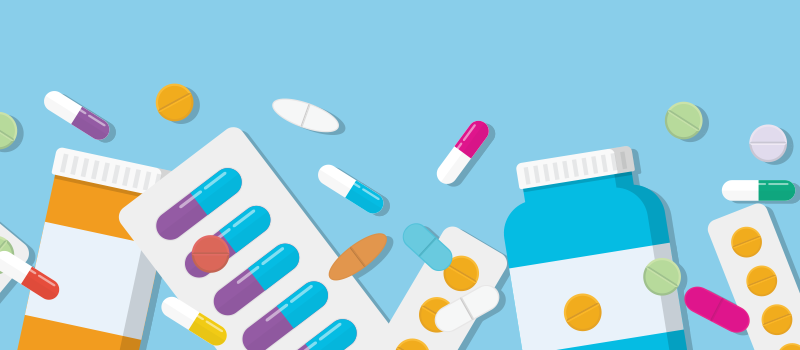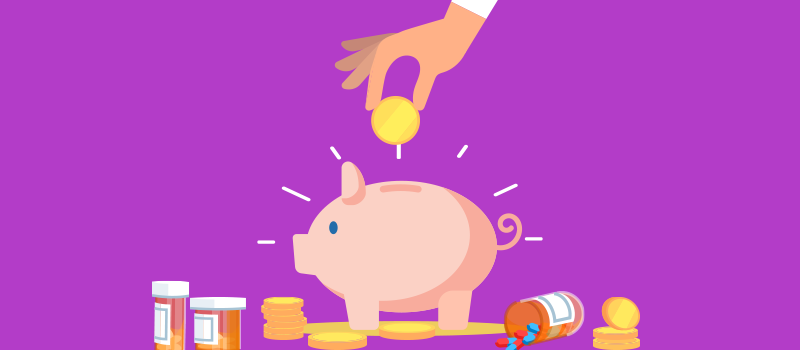What’s the Buzz
The Bee Healthy Blog
What Are the Most Common Antidepressant Side Effects?

About 13% of Americans aged 18 years and above use antidepressant medications, according to data from the National Health and Nutrition Examination Survey. These prescription medications, along with psychotherapy, also known as talk therapy, are used to treat major depressive disorder and other mental health conditions such as anxiety disorders. They are also used to treat chronic pain and sleep problems. Taking antidepressants can lead to a significant improvement in the symptoms of depressive disorders. However, it can also lead to unwanted adverse effects. Please continue reading to learn more about the different types of antidepressants and the common side effects of antidepressants.
What is the number one prescribed antidepressant?
There is limited data available, but sertraline (Zoloft) and fluoxetine (Prozac) are two of the most frequently prescribed antidepressants in the U.S.
Here are some of the most commonly prescribed types of antidepressants:
Selective serotonin reuptake inhibitors (SSRIs)
These are the most frequently prescribed types of antidepressants. They treat depression by increasing serotonin levels in the brain. Serotonin is a natural brain chemical that regulates mood, appetite, and sleep. Examples of SSRI antidepressants include fluoxetine (Prozac), sertraline (Zoloft), paroxetine (Paxil), citalopram (Celexa), and escitalopram (Lexapro).
Serotonin norepinephrine reuptake inhibitors (SNRIs)
These antidepressants affect the levels of chemicals in the brain called neurotransmitters, serotonin and norepinephrine. Examples of these mental health medications include venlafaxine (Effexor), desvenlafaxine (Pristiq), levomilnacipran (Fetzima), milnacipran (Savella), and duloxetine (Cymbalta).
Atypical antidepressants
Bupropion and mirtazapine are atypical antidepressants that work differently than SSRIs or SNRIs. Atypical antidepressants affect the levels of serotonin, norepinephrine, and dopamine in the central nervous system. Besides treating depression, bupropion is also used to treat seasonal affective disorder and aid smoking cessation. Other examples of antidepressants include trazodone, vortioxetine (Trintelix), vilazodone (Viibryd), and nefazodone. A new atypical antidepressant under the brand name Spravato (esketamine) is approved for treatment-resistant depression. Unlike other antidepressants, which are available as oral tablets, Spravato is a nasal spray.
Tricyclic antidepressants (TCAs)
This is an older group of antidepressants that are not prescribed frequently now because they tend to cause more side effects. Tricyclic antidepressants are not the preferred class of antidepressants when it comes to the treatment of depression; SSRIs and SNRIs are considered first-line options due to their safety and efficacy profile. However, TCAs still have their place in the treatment of anxiety and neurological disorders such as chronic pain, migraine, and fibromyalgia. Examples of tricyclic antidepressants include amitriptyline, desipramine, doxepin, nortriptyline, and imipramine.
Monoamine oxidase inhibitors (MAOIs)
This is a separate class of antidepressant medication used for treating depression and other mental health conditions such as social phobia and panic disorder. In addition to strict dietary restrictions, these antidepressant medications are not prescribed very often because of an increased risk of side effects and drug interactions compared to other medications. Examples of MAOIs include isocarboxazid, selegiline, phenelzine, and tranylcypromine.
What are common side effects of antidepressants?
Possible side effects of antidepressants are listed below. Some side effects go away after your body has some time to get used to the medication; however, if the side effects are too bothersome or persistent, your healthcare provider can adjust the dosing or prescribe a different antidepressant if the side effects from a particular medication are severe.
SSRIs: Drowsiness, dizziness, dry mouth, headache, nausea, vomiting, diarrhea, insomnia, agitation, restlessness, nervousness, appetite changes leading to weight loss or weight gain, sexual dysfunction, and difficulty reaching orgasm.
SNRIs: Dizziness, drowsiness, dry mouth, headache, nausea, constipation, loss of appetite, excessive sweating, fatigue, insomnia, sexual problems such as low sex drive, and erectile dysfunction.
Atypical antidepressant medications: Dizziness, drowsiness, dry mouth, headache, nausea, vomiting, stomach ache, constipation, loss of appetite, weight loss, uncontrolled shaking, ringing in the ears, changes in taste, excessive sweating, frequent urination, and sore throat.
Tricyclic antidepressants: Drowsiness, dry mouth, blurred vision, constipation, low blood pressure when going from sitting to standing, urinary retention, weight loss, increased appetite and weight gain, shakiness, increased sweating, sexual side effects such as low sexual desire, erectile dysfunction, and delayed orgasm.
MAOIs: Dry mouth, drowsiness, dizziness, lightheadedness, insomnia, nausea, diarrhea, and constipation.
What is the most prescribed antidepressant with no side effects?
Doctors usually start treatment for clinical depression by prescribing a selective serotonin reuptake inhibitor (SSRI) such as fluoxetine (Prozac), sertraline (Zoloft), paroxetine (Paxil), citalopram (Celexa), or escitalopram (Lexapro). These mental health medications are the least likely to cause side effects and are generally well-tolerated even at higher doses. However, like other medications, SSRIs can cause certain side effects. If the side effects are bothersome or don’t go away, your healthcare provider can adjust the dosing or start you on a different medication.
What is the best antidepressant with the least side effects?
All antidepressants can cause side effects. It may take some trial and error to find the one that works well for you to control depression symptoms without causing bothersome side effects that don’t improve after the first few weeks. For example, if a particular medication causes you to gain weight due to increased appetite. In this case, your doctor may try you on a new medication that does not cause these particular symptoms.
What is the safest antidepressant to be on?
SSRIs are usually the first choice among antidepressant medications because they tend to cause fewer side effects. However, taking antidepressants such as SSRIs is not entirely risk-free. For example, these drugs can lead to a dangerous condition called serotonin syndrome, in which there is too much serotonin in the body.
Other factors can also affect the safety profile of an antidepressant. For example, if you drink alcohol while on an antidepressant like Wellbutrin SR or Effexor XR, it can make side effects such as dizziness and drowsiness worse, increasing your risk of falls, accidents, and injuries.
What is the most risky antidepressant?
All antidepressants carry risks. For instance, many antidepressants can increase suicidal thoughts and behaviors in young adults. Suicide risk is especially high in the first few weeks of treatment and after dosage adjustments.
That said, newer antidepressants are generally safer and better tolerated than older ones. Some studies have found that tricyclic antidepressants and monoamine oxidase inhibitors may be riskier than other antidepressants, such as SSRIs, SNRIs, and atypical antidepressants. For example, being compliant to strict dietary restrictions is very crucial while on an MAOI. However, there is a risk associated with taking any antidepressant.
Also, remember, everyone is different. You may have bothersome side effects on serotonin modulators such as SSRIs and SNRIs but do well on certain antidepressants that are less frequently prescribed.
Based on your past medical history, family history, and current medications, finding the best antidepressant with the least side effects comes down to trial and error. Other factors to keep in mind when choosing between different types of antidepressants include your particular depression symptoms, your other health conditions, interactions with other medications, including prescription and over-the-counter medicines and herbal supplements, pregnancy and breastfeeding limitations, and health insurance coverage.
References:
- https://www.cdc.gov/nchs/products/databriefs/db377.htm
- https://www.frontiersin.org/articles/10.3389/fpsyt.2020.00035/full
- https://magazine.medlineplus.gov/article/commonly-prescribed-antidepressants-and-how-they-work
- https://www.mayoclinic.org/diseases-conditions/depression/in-depth/antidepressants/art-20046983
- https://www.ncbi.nlm.nih.gov/books/NBK539848/
- https://www.mayoclinic.org/diseases-conditions/depression/in-depth/ssris/art-20044825
- https://www.mayoclinic.org/diseases-conditions/depression/in-depth/antidepressants/art-20044970
- https://medlineplus.gov/druginfo/meds/a695033.html
- https://www.mayoclinic.org/diseases-conditions/depression/in-depth/antidepressants/art-20046273
- https://www.thecarlatreport.com/articles/2601-which-are-the-most-dangerous-antidepressants-












SOCIAL